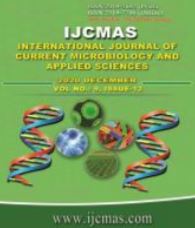


 National Academy of Agricultural Sciences (NAAS)
National Academy of Agricultural Sciences (NAAS)

|
PRINT ISSN : 2319-7692
Online ISSN : 2319-7706 Issues : 12 per year Publisher : Excellent Publishers Email : editorijcmas@gmail.com / submit@ijcmas.com Editor-in-chief: Dr.M.Prakash Index Copernicus ICV 2018: 95.39 NAAS RATING 2020: 5.38 |
The present study is restricted to NBHC’s branch of Jaipur district of Rajasthan state and carried out in the year 2019. 50 traders were selected for the study of warehouse space availability, from the selected 5 mandies as working area of NBHC and 50 farmers were selected for the study of marketable and marketed surplus of food grain, from 3 major food grain production taluka of Jaipur district. It is observed that NBHC follows the operational practices in a very good manner, which required for a good warehousing business. NBHC deals in some services named as professional warehousing, collateral management services, quality and certification, commodity care and pest control and trade facilitation. NBHC have own in-house ERP (OMNIFLOW) for recording the transections from the field, and a vertical audit process named as MANDAT which conducts frequent surprise audits at warehouses and offices and has an in-house commodity care and pest management wing. The storage losses in warehouses calculated as the difference between weight of inward quantity and outward quantity. The higher losses noticed in December 2018(473.55 MT), April 2019 (461.55 MT) and June 2019 (413.65 MT). For the reduction of storage losses, NBHC do the better practices as like fumigation, time to time cleaning of warehouses, using good packing materials etc. Also the warehouses have guards and double lock and key system, which avoid theft attack. The study of marketable and marketed surplus of Food Grain showed that 83.11 per cent of total production of Food Grain was available for selling after deduction of self uses, animal feeding uses and seeds. The per cent of marketable surplus (83.11%) and gross marketed surplus (80.82%) didn’t have too much difference which indicates that farmers are not able to stock their produces or they are not interested to stock because they need instant money for the sowing of next crop or household uses. The difference between gross marketed surplus (80.82%) and net marketed surplus (79.75%) indicates that Food Grain producer farmers were not purchasing.
 |
 |
 |
 |
 |